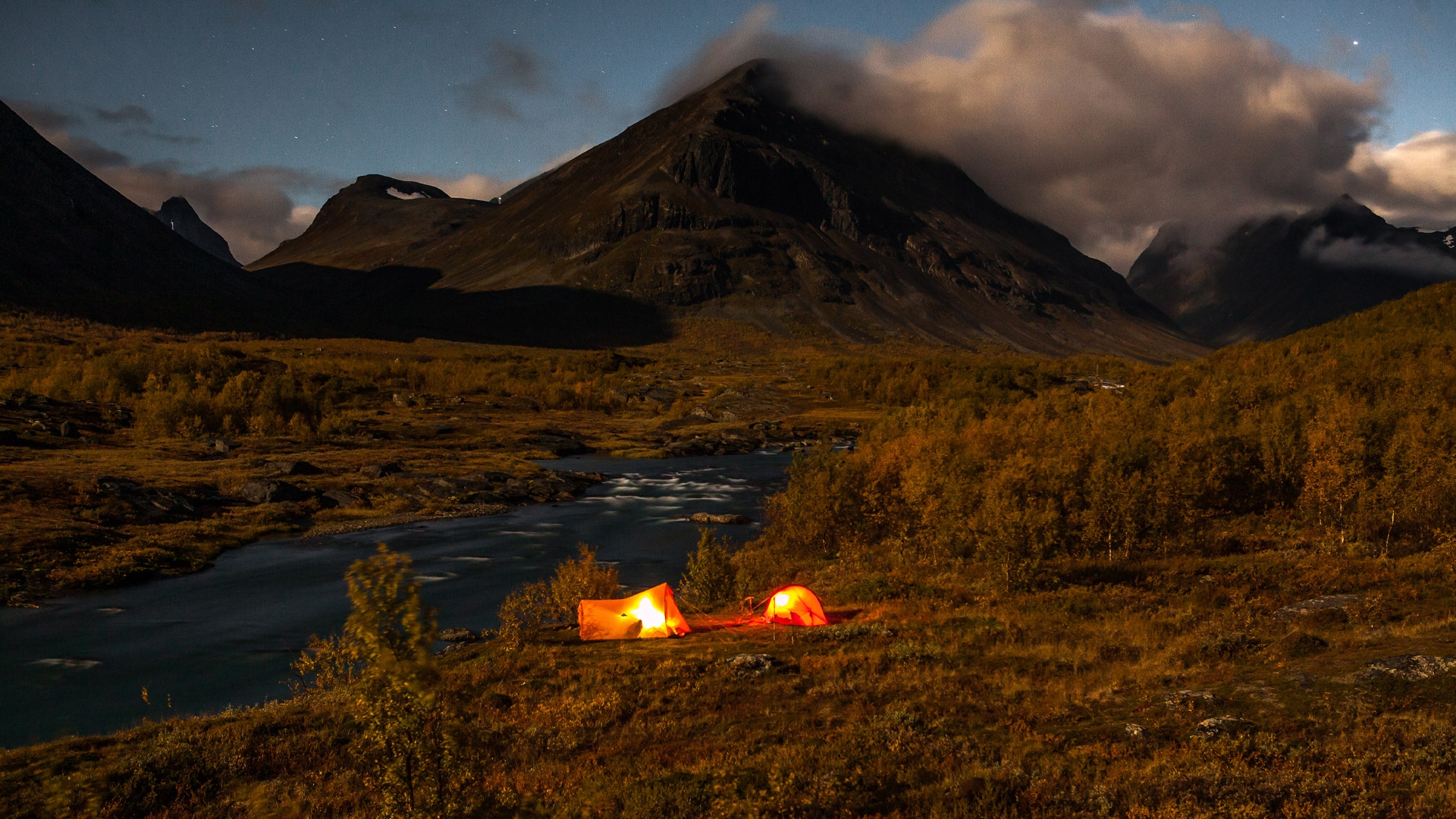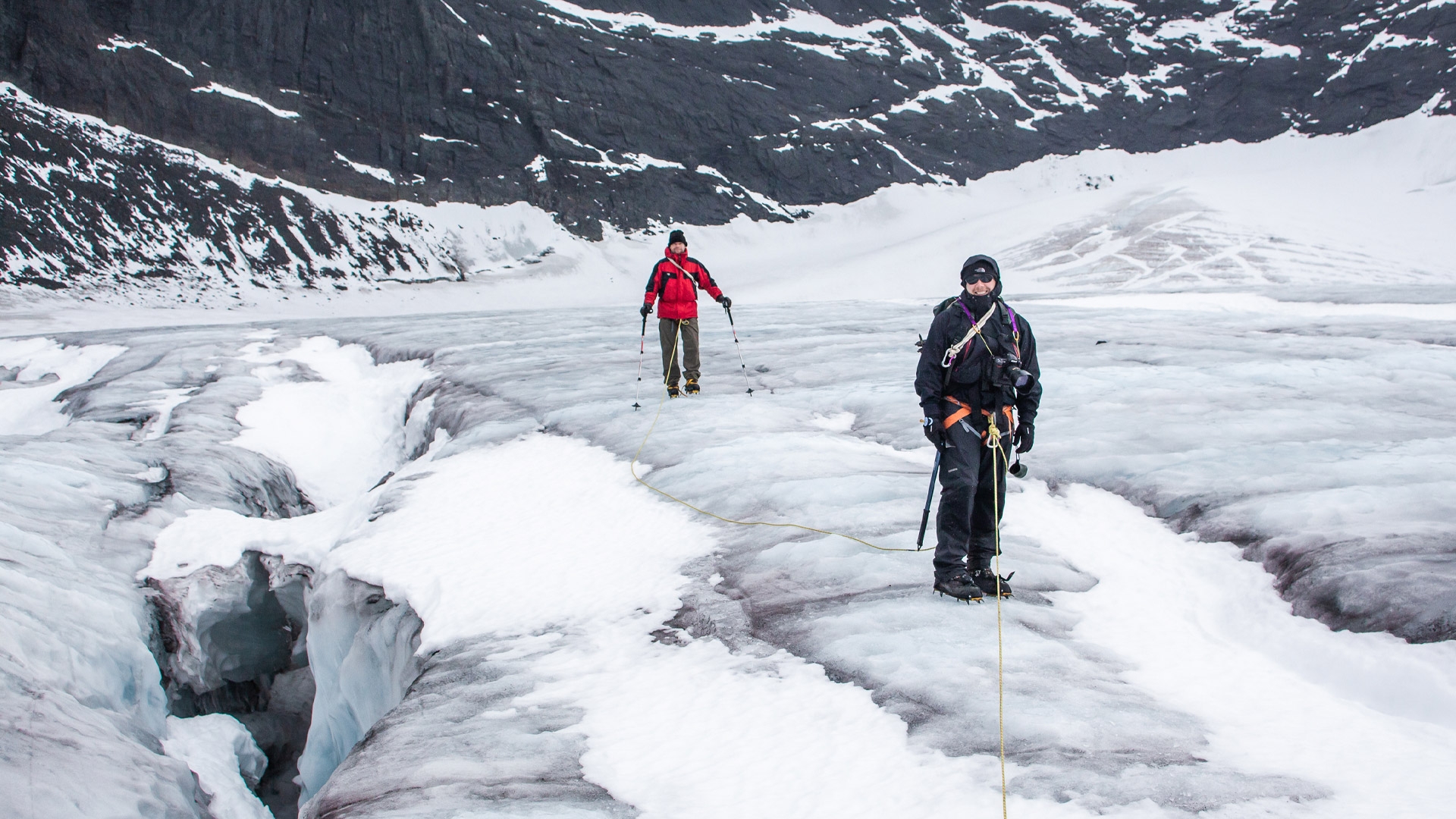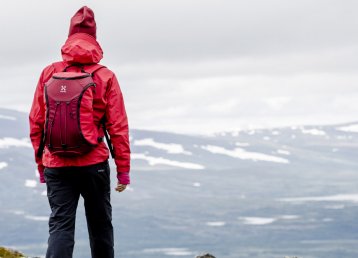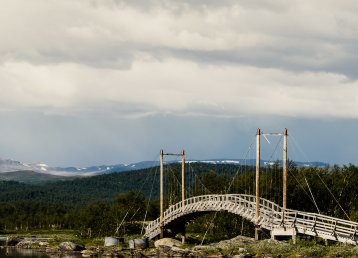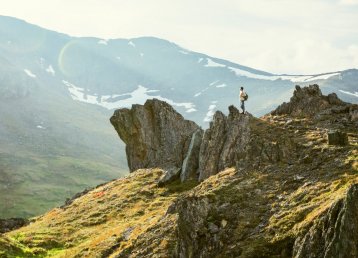We have chosen the time and place with care. Visttásvággi, the wide valley stretching north from Nikkaluokta, is a gem to experience during autumn. The lower part of the valley is wide and lush, but in its upper part the valley gets narrower, and the steep slopes remind us of the greatness of the mountains. From Nikkaluokta we take a boat ride for the first kilometres up the valley. It is the beginning of September, and the colours in the lower part of the valley have started to change. The air is fresh and clear. I sit in the boat, enjoying the amazing nature that surrounds me. To me, this is the best time of year in the mountains. Sure, July and August are high-season, but that means there are more people, that the sun warms up the tent a little too early in the mornings, and that the mosquitoes in lowland terrain are a little intrusive. I dismiss those thoughts; it is fantastic to have all this to yourself and thus ‘here and now’ is the best attitude. Once we have been dropped off and the sound of the boat engine has faded, all we hear are ourselves and the murmuring Visttasjohka. We hike north at a leisurely pace through the mountain birch forest. We follow Visttasjohka, and the lower part of this stream is more like a narrow river. After a few hours’ hiking, we arrive at the Vistas cabin. We take a break and talk to the cabin host for a while. Last week was calm, she says. In a few days, it is time for her to close up. We agree that this is the best time of year for hikers and that this valley is the most beautiful in autumn. A couple of hours later, we set up camp on the slope at Siehtagas. The low evening sun illuminates Nallopiken, a very characteristic peak a bit higher up in Stuor-Reaiddivaggi.
That first night in a tent
The first night in a tent is special, every trip. Your body is not used to the camping mattress, but the feeling of being outdoors is as great every time. There is nothing to disturb you here. Reality and everyday life are left to fend for themselves. During a mountain trip, your mind adapts to enjoying the surroundings, hiking, watching where you put your feet. I wake up early, and as usual, I lie there needing to pee for a while before I summon the strength to go outside. There is fog down in Visttásvággi. The view is monumental. My movements wake my friends, and we begin the usual ritual, unpacking camping stoves and making breakfast. Everyone has their own favourite, and I normally eat a mixture of oatmeal and blueberry soup – something that might not impress a gourmet hiker, but it fills me with energy. The first day is a bit of a ‘travel day’. The second day, on the other hand, is more ‘for real’. Today we will hike a fairly short distance up through Stuor-Reaiddivaggi before we rehearse glacier safety in the afternoon. The hike through the valley offers an increasingly high-alpine character. Nallo is a cabin site, but the cabin has closed for the season. We set up our tents, have lunch and then start to rehearse how to walk as rope teams. The plan for the next day is to cross a pass – with a glacier – in the almost virgin valley Påssusvággi. Glaciers require rope and safety techniques, and as knowledge tends to expire, we rehearse our skills. Knowledge always opens up new paths and opportunities.
Different kind of hikers
There are probably as many reasons for hiking as there are hikers. For some, nature experiences are in focus: experiencing beautiful mountain scenery, summer nights, and feeling like part of nature. To others, it is a break from everyday life – getting away from the daily grind and city noise. Perhaps to travel off the beaten path, in areas where few others visit. Some like cultural encounters, where locals and hikers meet along hiking trails, in mountain cabins and at mountain stations. Some are attracted to high-alpine areas, the adventure and the challenge. Yet others prefer travelling along trails in the valleys, near cabins and safety. To many, it is important to be able to sleep under a roof or in a bed, or with hotel standard at a mountain station. From there they can make day trips, take a sauna, enjoy cooked food and a comfortable bed. As for me, I place the focus on nature, but also on time happily spent with friends; I do not see that often. Hiking together like this, we have all the time in the world. Photography could be another motivation, and autumn is something very special in the mountains. During the end of August and until mid-September, this region is transformed into a magnificent glory of colour before autumn-winter takes its hold on the landscape. It is a short but intense period of splendour. There are few visitors, and the mosquitoes have frozen to death. In September the dark nights have returned, so there is a great chance of experiencing the northern lights. A time of contrasts – no matter what kind of hiker you are.
Priorities
I like to move easily. A common way to ruin your stay in the mountains is bringing too much stuff. A heavy pack straining your knees, joints and shoulders will end up putting a strain on the entire experience. But everyone who has been out hiking a lot has made the same mistake: hikes where the main feeling has been that of pain. I spoke to Jörgen Johansson, author of the book “Vandra Fjäderlätt” (Featherlight Hiking). He believes it is important to decide what kind of hiker you are: the camp hiker or the distance hiker?
What hiker you are will influence the priorities you make. If you are a pronounced long-distance hiker, it is extremely important to think about your equipment to ensure you do not carry too much, whilst having everything you need. Distance hikers often have a routine where they make do with a little less. Hikers who place value on cosy camps and prefer shorter day trips can treat themselves to a little extra. If truth be told, most of us are somewhere in between. We want to experience what is behind the next peak, and at the same time have the luxury of a camp. Unfortunately, the combination is almost impossible.
For me, it is about challenging my prejudices and stereotypes and being critical when going through the packing list. A modern backpack weighs 3.5 kilos or more on its own. I almost exclusively hike in low trail shoes. They have been proven to work well. I normally use thin, quick-drying nylon socks. Some people say you must wear boots, but I say it depends. Boots are great, but if you carry two kilos on your feet, it corresponds to the same increase in energy expenditure as ten kilos on your back. The most important thing is probably not to head out there with something you have not tested. Never hike wearing new boots or shoes. Try out at home which combination of socks and shoes you prefer – and do so while wearing a packed rucksack. Familiarise yourself with how your feet behave. If you are prone to blisters, use preventive plasters. Blisters can turn the most wonderful hike into something really horrid.
Crossing the glacier
Passing the Nallo cabin, a laborious hike begins up Šielmmávággi, a valley that opens up to the Tjäktjastugan cabin and the King’s Trail. But after two kilometres we turn off north and continue through rockier terrain to a small lake, where the actual ascent to the pass begins. The terrain is not beginner-friendly. The stones are large and slippery. If you move in this kind of terrain, you need to watch your step. As we reach the glacier Västra Bossos, it is almost a relief to don crampons and steps out on even ice. The glacier is melted bare and easy to walk on, but we still tie into rope teams. On the other side, Bossosvággi opens up in front of us. We camp a bit below the glacier; the weather is clear and nice and soon down jackets appear. We are some five hundred metres higher up than Visttásvággi and temperatures drop by about one degree per hundred meters, so when the sun disappears behind the steep mountains, it gets cold quickly. In early September the weather can be very unforgiving. Snow is not uncommon, and especially at altitude temperatures can drop to several degrees below zero during the night. I always bring a light down jacket this time of year, as well as a hat and warm gloves. A warm sleeping bag is an absolute must, of course, with a comfort temperature of several degrees below zero. The eight seasons are very noticeable when you spend time out and about, experiencing nature more directly.
Far from light pollution
As darkness falls, a twinkling starry sky lights up above us. We are far from light pollution here in the middle of the Šielmmáčohkka massif. For a long time, Šielmmáčohkka was thought to be 1,997 metres high, but new measurements have shown that the mountain is 2,004 metres high, thus joining the 2,000+ group of peaks. Bossosvággi is a valley that probably very few choose to visit. From the north-west, it is easy to reach from the King’s Trail, but since the valley is a cul-de-sac unless you carry glacier equipment, not many ventures into it. The hike down through the valley cuts through amazing grass heaths – divine campsites. The slopes are barren and mountainous, and behind us, the peaks of Šielmmáčohkka rise, creating a high-alpine feeling. After some kilometres, the valley widens, and soon, we can see the river Aliseatnu glistening down in the wide Alisvággi valley. In the distance, we see the elongated lake Alisjávri. That is our stage goal for today – the Alesjaure cabins, a slightly larger site with a shop and a sauna located along the King’s Trail. The King’s Trail feels like a motorway compared to the crossing from the Nallo cabin. The King’s Trail is our most famous hiking trail, stretching from Abisko in the north to Hemavan in the south. The most frequently hiked stretch is the northern one, where we are. The Swedish Tourist Association (STF) cabins are located suitable day stages apart. If you choose to hike the northern part of the King’s Trail, you can hike easily and enjoyably without tents and camping equipment. Most people will have what is needed for this kind of hike.
Mountain hiking
Comfortable and broken-in shoes or boots, normal outdoor clothing, rain gear, a warm jumper, gloves and a duvet-style sleeping bag will get you far along the King’s Trail. There is no need for membrane garments and expedition tents. If we were to take the drama out of mountain hiking, more people would probably have a go at it, discovering all the amazing things about moving on foot in this magnificent terrain. More people would be able to afford it, too. This is something of a message I would like to give: different hikes require different equipment and preparation. A three-week autumn trek in Sarek obviously requires other equipment than a hike along the King’s Trail in August, staying in cabins. I have hiked since I was a kid; first with my parents, then a few trips on my own before my interest in nature led me to officer training at the Lapland Ranger Regiment in Kiruna. The regiment required us to hike long distances with extreme packing – the position as ranger demanded it. I remember my first mountain hike after the military service: old habits had me pack a rucksack based on a military mindset, and the result was a Sarek trek that was anything but enjoyable, with a rucksack that weighed well over thirty kilos. It was an eye-opener, and when I later hiked the Annapurna Circuit in Nepal, my pack was a lot lighter. I was inspired by the experienced mountain inhabitants there, hiking with something we would call lightweight packing today. It is not difficult; actually, you just have to be practical. Use your common sense.
Alesjaure
Down at STF Alesjaure, we are met by three happy ladies around retirement age, working as cabin hosts. They quickly make us an offer: if we take care of the pile of firewood, they will forfeit the cost of the accommodation. They are preparing to close down, and when the winter season opens, all the cabins must be prepared, with firewood inside. Cheerfully we accept the task, and soon the cabins are all set with newly chopped firewood stacked inside. After three nights in the open, it is a great feeling to arrive at a small shop, have a sauna and sleep indoors. STF Alesjaure is beautifully situated on top of a small hill, just south of Lake Alisjávri. From Alesjaure we continue two kilometres along the King’s Trail, heading north until we turn off east into the upper part of Visttásvággi. Upper Visttásvággi is probably one of the most beautiful valleys in the mountain world: narrow, and framed by steep mountainsides. The vegetation gradually increases, and after a couple of days, the autumn colour show begins to reach its peak. It is difficult not to stop and take photos all the time. On the surrounding mountain peaks, the first snow has begun to settle. When we return to the Vistas cabin, the cabin host has gone home. An elk greets us, and the Nallúpiken mountain is covered in clouds. The wind blusters through the valley. Leaves dance in the breeze. A different time is approaching.














